Pantry food containers: glass or plastic?
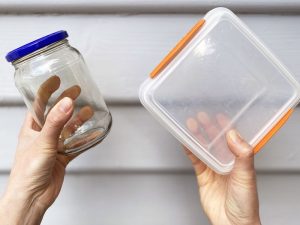 This article has been written by Angela Chung, who lives in Macleod. Angela used to operate her own small business called Pop-Up Pantry, which was an online store delivering pantry and household cleaning products direct to homes within 10km of Macleod.
This article has been written by Angela Chung, who lives in Macleod. Angela used to operate her own small business called Pop-Up Pantry, which was an online store delivering pantry and household cleaning products direct to homes within 10km of Macleod.
When you open your pantry, do you see plastic or glass containers? Which one would you like to have? This article discusses the pros and cons of plastic and glass containers by considering 6 factors, namely purpose, personal health, environment, cost and aesthetic. Hopefully, it will help you to make the choice of the containers in your pantry.
This table below provides my overall assessment for each of the factors.
| Factor | Feature and benefit | Glass | Plastic |
| Purpose | Transparency: easy to see contents | Yes | Yes |
| Durability from stain and scratch | Yes | No | |
| Stackable | Not so much | Yes | |
| Transportable: lightweight | No | Yes | |
| Keep food better flavour and fresh | Yes | No | |
| Children friendly / not breakable | No | Yes | |
| Large bulk capacity more than 2 litres | No | Yes | |
| Easily washable from stain and smell | Yes | Not always | |
| Personal health | Safe from chemical releases | Yes | Not always |
| Environment | Recyclable | Yes | Limited |
| Cost | Inexpensive and affordable | No | Yes |
| Aesthetics | Better looks | Yes | No |
| Total score of ‘yes’ | 7 | 6 |
Plastic is convenient, lighter, cheaper and a space saver
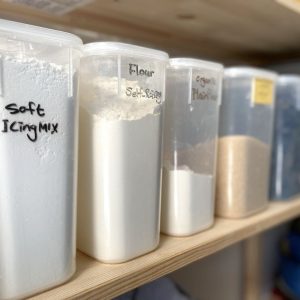 I think that we can all agree that plastic containers are better for storage. That’s why they have been popular for containing food since they were invented in 1950s. They save space by being easily stackable and their light weight makes them easy to transport and get re-filled dry bulk food. 90% of my pop-up pantry customers bring plastic containers. They are inexpensive and available in any supermarket. And, of course, you don’t need to worry about them breaking to pieces by dropping.
I think that we can all agree that plastic containers are better for storage. That’s why they have been popular for containing food since they were invented in 1950s. They save space by being easily stackable and their light weight makes them easy to transport and get re-filled dry bulk food. 90% of my pop-up pantry customers bring plastic containers. They are inexpensive and available in any supermarket. And, of course, you don’t need to worry about them breaking to pieces by dropping.
However, the downside is that the plastic can be easily stained, scratched, and stuck with previous food content. One major issue for me is that the colour and clearness gets lost over time and another issue is that they are not so easy to clean in a dishwasher. By contrast, glass tends to hold its shape better, be durable, remain clear colour, and it keeps the freshness and flavour of food, particularly wet ingredients.
Glass is beautiful and always looks new
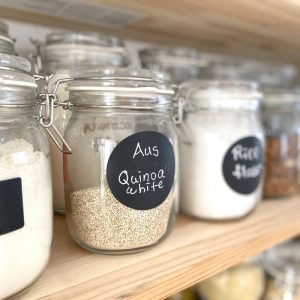 Plastic containers can look tired, lost shape and scratched over time. It doesn’t matter how I wash my plastic containers, they don’t look the same as when they were new. Oil and colour stains can be hard to remove too.
Plastic containers can look tired, lost shape and scratched over time. It doesn’t matter how I wash my plastic containers, they don’t look the same as when they were new. Oil and colour stains can be hard to remove too.
By contrast, glass containers can look new after a hot and soapy water clean! I recommend the heavy-duty mode in the dishwasher to achieve this. Glass can also be sterilised. If cleaned properly, they can look fabulous on open shelves!
Both plastic and glass can have an issue with stinky food smells. Greenmatters (https://www.greenmatters.com/p/how-to-get-the-smell-out-of-jars-etc) has a few tips for removing the odours: leave bicarb soda paste or a white vinegar & water mixture inside the jar overnight before rinsing off the next day; and, if the metal lid is still stinky, leave it in direct sunlight.
Glass is better for the environment
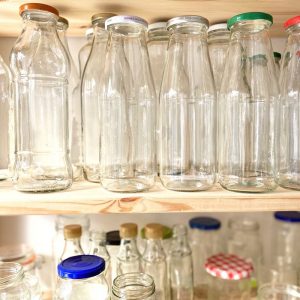 When it comes to durability, longevity, and its ability to be recycled, glass is the winner! Glass containers for food and beverages are 100% recyclable and can be recycled endlessly without loss in quality or purity, whereas most plastic will end up in a landfill.
When it comes to durability, longevity, and its ability to be recycled, glass is the winner! Glass containers for food and beverages are 100% recyclable and can be recycled endlessly without loss in quality or purity, whereas most plastic will end up in a landfill.
(Note that other types of glass, like windows, ovenware, Pyrex and crystal, are all manufactured through different processes and, although theoretically 100% recyclable, may not be in practice, depending on the local council’s facilities and capacity. See www.gpi.org/glass-recycling-facts.).
Glass is safer for health
I have read some disturbing things about the potential health hazards of plastic. Most plastic food containers are made using polycarbonate plastics, some of which have bioactive chemicals, like bisphenol A (BPA) and phthalates. BPA and phthalates can interfere with the body’s normal use of hormones; not just estrogen and testosterone but also thyroid and adrenal hormone production. They can apparently cause physical change, including genital changes that can cause lower sperm count in boys (see www.fatherly.com). To minimise these risks, make sure that any plastic containers you acquire are free of BPA and phthalates. Also, never microwave your food in plastic containers.
By contrast, glass doesn’t have any health issues unless it broken into sharp pieces become a hazard. Also, glass has a non-porous surface that doesn’t absorb like plastic and can be safely washed at higher temperatures in your dishwasher without melting or warping.(see www.epicurious.com/expert-advice).
My conclusion
For the environmental and health reasons discussed above, I now choose glass. I used to use a lot of plastic takeaway containers that I collected over the years ands I loved them because they were so cheap (most free), light, stackable and clear (to see their contents). But I changed my mind and replaced them with glass containers when I learned how harmful single-use containers can be if repeatedly used. Buying new glass containers was an expensive investment but I decided to do the right thing for my family. I also like that glass is durable, long-lasting and looks great.
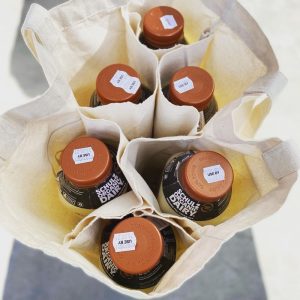 Note that I still use plastic food containers for large bulk food items, including rice and flour. The biggest problem of glass containers is hard to transport due to their weight. My solution for this is to use a foldable trolley with fitted pockets, for example when I go to farmers’ markets.
Note that I still use plastic food containers for large bulk food items, including rice and flour. The biggest problem of glass containers is hard to transport due to their weight. My solution for this is to use a foldable trolley with fitted pockets, for example when I go to farmers’ markets.
Also note that stackable rectangular glass jars with plastic airtight lids are suitable for meat and dairy products and your local butcher should be willing to fill such containers for you.
And if you still want to use lightweight, affordable plastic containers?
Make sure to get high quality, BPA-free containers, clean them often, and keep using them as long as you can.
References
Glass vs plastic containers. What’s best for you and your food?
Plastic or glass: which food storage container is best?
Zero-waste methods to get your jars stink-free and label-less.
BPA & phthalates: the reason why plastic is dangerous for children.

The best jars for storage are canning jars with their canning lids and rings. Often, the jars which already have been filled with various foods have lids that do not seal completely once opened and insects can get inside. You would need to inspect the lids to see if they have a soft ring on the inside which may provide a seal (although may not). Canning jars and lids are the most reliable.
Hi,
Great article, I can’t picture the stackable glass containers with plastic lids? Can you please send me a link?
Also what do you think of silicone bags?
Many thanks
Susie
Hi Susanna,
Thanks for your comments.
Here is a link that is an example of my photos.
https://www.instagram.com/p/CRDxW-tlr8i/
I use this container to store fresh food or leftover meals in the fridge and heat the oven or microwave. I can also it in the freezer. It is heavy but multi-purpose! There is a wooden lid with silicone seal available too.
I have found that silicon bags are very handy to carry small liquid foods and store in the fridge/freezer. Perhaps too limited in their space for me to store food. Also, although silicone is safe and comes from a natural source, it requires special recycling systems that are not common in Australia. So, I prefer glass containers or even simple kitchen towels/ cotton bags for non-liquid food.
What do you think about silicone bags?
Angela
I used to store all my pantry stuff in glass containers but due to arthritic hands and unforgiving floors had to switch to plastic.
Hi Gillian,
I understand some glass jar lids are hard to open sometimes. Even my mother struggled to open soft-close kitchen cupboard doors due to arthritis. Have you tried a silicon seal wooden lid type for glass jars? In the end, keeping re-using containers is the main thing to organise the pantry and close the loops of the linear economy.
Hi Angela,
Thanks for your helpful article highlighting these everyday decisions we all make.
By way of addition to the glass vs plastic discussion, I wanted to share how I have been able to move all of my dry goods storage into 100% glass jars at zero cost (and to great aesthetic satisfaction). This might be a good option for some people considering the ‘cost’ analysis part of the great chart you created.
Clean and empty jars which usually end up in the recycling after supermarket shopping are ideal for dry goods storage. Passata jars are tall and thin, so fill to a reasonable height in our cupboard, with no need to stack. I find the volume is a great fit for dry goods like legumes and nuts. Ex- hummus or dip jars (something like taco sauce jars) are squat and round with a wide lid – good for herbs and spices, and safe to stack. And my flours and other large volume items are now stored in 2.2L jars that were one-off purchases of olives or pickles, from places like the Mediterranean Wholesaler in Sydney Road. Our friends were addicted to Polish pickled cucumbers for a while, so we ended up with a perfect set of their emptied jars which are now very handsome on our kitchen shelf.
Hi Karen,
Thanks for sharing your thought and your experiences.
It is nice to hear you have been reused the product glass jars. It sounds like you enjoy all the glass containers and are well organised!
I agree that we can get great glass containers when you choose the right products in glass. I have been seen them from some of my pop-up pantry customers brought to refill! Such useful containers. We should keep supporting those wonderful products in glass containers too.
Angela